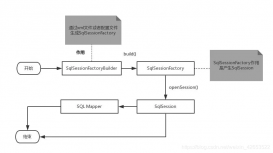BeetSql是一個(gè)全功能DAO工具, 同時(shí)具有hibernate 優(yōu)點(diǎn) & Mybatis優(yōu)點(diǎn)功能,適用于承認(rèn)以SQL為中心,同時(shí)又需求工具能自動(dòng)能生成大量常用的SQL的應(yīng)用。
beatlsql 優(yōu)點(diǎn)
-
開(kāi)發(fā)效率
- 無(wú)需注解,自動(dòng)使用大量?jī)?nèi)置SQL,輕易完成增刪改查功能,節(jié)省50%的開(kāi)發(fā)工作量
- 數(shù)據(jù)模型支持Pojo,也支持Map/List這種快速模型,也支持混合模型
- SQL 模板基于Beetl實(shí)現(xiàn),更容易寫(xiě)和調(diào)試,以及擴(kuò)展
-
維護(hù)性
- SQL 以更簡(jiǎn)潔的方式,Markdown方式集中管理,同時(shí)方便程序開(kāi)發(fā)和數(shù)據(jù)庫(kù)SQL調(diào)試。
- 可以自動(dòng)將sql文件映射為dao接口類
- 靈活直觀的支持支持一對(duì)一,一對(duì)多,多對(duì)多關(guān)系映射而不引入復(fù)雜的OR Mapping概念和技術(shù)。
- 具備Interceptor功能,可以調(diào)試,性能診斷SQL,以及擴(kuò)展其他功能
-
其他
- 內(nèi)置支持主從數(shù)據(jù)庫(kù)支持的開(kāi)源工具
- 支持跨數(shù)據(jù)庫(kù)平臺(tái),開(kāi)發(fā)者所需工作減少到最小,目前跨數(shù)據(jù)庫(kù)支持mysql,postgres,oracle,sqlserver,h2,sqllite,DB2.
引入依賴
|
1
2
3
4
5
6
7
8
9
10
11
12
13
14
15
16
17
18
19
20
21
22
23
24
|
<dependency> <groupId>org.springframework.boot</groupId> <artifactId>spring-boot-devtools</artifactId> <optional>true</optional> </dependency> <dependency> <groupId>com.ibeetl</groupId> <artifactId>beetl</artifactId> <version>2.3.2</version> </dependency> <dependency> <groupId>com.ibeetl</groupId> <artifactId>beetlsql</artifactId> <version>2.3.1</version> </dependency> <dependency> <groupId>mysql</groupId> <artifactId>mysql-connector-java</artifactId> <version>5.0.5</version> </dependency> |
這幾個(gè)依賴都是必須的。
整合階段
由于springboot沒(méi)有對(duì) beatlsql的快速啟動(dòng)裝配,所以需要我自己導(dǎo)入相關(guān)的bean,包括數(shù)據(jù)源,包掃描,事物管理器等。
在application加入以下代碼:
|
1
2
3
4
5
6
7
8
9
10
11
12
13
14
15
16
17
18
19
20
21
22
23
24
25
26
27
28
29
30
31
32
33
34
35
36
37
38
39
40
41
42
43
44
45
46
47
48
49
50
51
52
53
54
55
56
57
58
59
60
61
62
63
64
|
@Bean(initMethod = "init", name = "beetlConfig") public BeetlGroupUtilConfiguration getBeetlGroupUtilConfiguration() { BeetlGroupUtilConfiguration beetlGroupUtilConfiguration = new BeetlGroupUtilConfiguration(); ResourcePatternResolver patternResolver = ResourcePatternUtils.getResourcePatternResolver(new DefaultResourceLoader()); try { // WebAppResourceLoader 配置root路徑是關(guān)鍵 WebAppResourceLoader webAppResourceLoader = new WebAppResourceLoader(patternResolver.getResource("classpath:/templates").getFile().getPath()); beetlGroupUtilConfiguration.setResourceLoader(webAppResourceLoader); } catch (IOException e) { e.printStackTrace(); } //讀取配置文件信息 return beetlGroupUtilConfiguration; } @Bean(name = "beetlViewResolver") public BeetlSpringViewResolver getBeetlSpringViewResolver(@Qualifier("beetlConfig") BeetlGroupUtilConfiguration beetlGroupUtilConfiguration) { BeetlSpringViewResolver beetlSpringViewResolver = new BeetlSpringViewResolver(); beetlSpringViewResolver.setContentType("text/html;charset=UTF-8"); beetlSpringViewResolver.setOrder(0); beetlSpringViewResolver.setConfig(beetlGroupUtilConfiguration); return beetlSpringViewResolver; } //配置包掃描 @Bean(name = "beetlSqlScannerConfigurer") public BeetlSqlScannerConfigurer getBeetlSqlScannerConfigurer() { BeetlSqlScannerConfigurer conf = new BeetlSqlScannerConfigurer(); conf.setBasePackage("com.forezp.dao"); conf.setDaoSuffix("Dao"); conf.setSqlManagerFactoryBeanName("sqlManagerFactoryBean"); return conf; } @Bean(name = "sqlManagerFactoryBean") @Primary public SqlManagerFactoryBean getSqlManagerFactoryBean(@Qualifier("datasource") DataSource datasource) { SqlManagerFactoryBean factory = new SqlManagerFactoryBean(); BeetlSqlDataSource source = new BeetlSqlDataSource(); source.setMasterSource(datasource); factory.setCs(source); factory.setDbStyle(new MySqlStyle()); factory.setInterceptors(new Interceptor[]{new DebugInterceptor()}); factory.setNc(new UnderlinedNameConversion());//開(kāi)啟駝峰 factory.setSqlLoader(new ClasspathLoader("/sql"));//sql文件路徑 return factory; } //配置數(shù)據(jù)庫(kù) @Bean(name = "datasource") public DataSource getDataSource() { return DataSourceBuilder.create().url("jdbc:mysql://127.0.0.1:3306/test").username("root").password("123456").build(); } //開(kāi)啟事務(wù) @Bean(name = "txManager") public DataSourceTransactionManager getDataSourceTransactionManager(@Qualifier("datasource") DataSource datasource) { DataSourceTransactionManager dsm = new DataSourceTransactionManager(); dsm.setDataSource(datasource); return dsm; } |
在resouces包下,加META_INF文件夾,文件夾中加入spring-devtools.properties:
|
1
2
|
restart.include.beetl=/beetl-2.3.2.jarrestart.include.beetlsql=/beetlsql-2.3.1.jar |
在templates下加一個(gè)index.btl文件。
加入jar和配置beatlsql的這些bean,以及resources這些配置之后,springboot就能夠訪問(wèn)到數(shù)據(jù)庫(kù)類。
舉個(gè)restful的栗子
初始化數(shù)據(jù)庫(kù)的表
|
1
2
3
4
5
6
7
8
9
10
|
# DROP TABLE `account` IF EXISTSCREATE TABLE `account` ( `id` int(11) NOT NULL AUTO_INCREMENT, `name` varchar(20) NOT NULL, `money` double DEFAULT NULL, PRIMARY KEY (`id`)) ENGINE=InnoDB AUTO_INCREMENT=4 DEFAULT CHARSET=utf8;INSERT INTO `account` VALUES ('1', 'aaa', '1000');INSERT INTO `account` VALUES ('2', 'bbb', '1000');INSERT INTO `account` VALUES ('3', 'ccc', '1000'); |
bean
|
1
2
3
4
5
6
7
8
9
10
|
public class Account { private int id ; private String name ; private double money; getter... setter... } |
數(shù)據(jù)訪問(wèn)dao層
|
1
2
3
4
5
|
public interface AccountDao extends BaseMapper<Account> { @SqlStatement(params = "name") Account selectAccountByName(String name);} |
接口繼承BaseMapper,就能獲取單表查詢的一些性質(zhì),當(dāng)你需要自定義sql的時(shí)候,只需要在resouses/sql/account.md文件下書(shū)寫(xiě)文件:
|
1
2
3
4
5
|
selectAccountByName===*根據(jù)name獲account select * from account where name= #name# |
其中“=== ”上面是唯一標(biāo)識(shí),對(duì)應(yīng)于接口的方法名,“* ”后面是注釋,在下面就是自定義的sql語(yǔ)句,具體的見(jiàn)官方文檔。
web層
這里省略了service層,實(shí)際開(kāi)發(fā)補(bǔ)上。
|
1
2
3
4
5
6
7
8
9
10
11
12
13
14
15
16
17
18
19
20
21
22
23
24
25
26
27
28
29
30
31
32
33
34
35
36
37
38
39
40
41
42
43
44
45
46
47
48
49
50
51
|
@RestController@RequestMapping("/account")public class AccountController { @Autowired AccountDao accountDao; @RequestMapping(value = "/list",method = RequestMethod.GET) public List<Account> getAccounts(){ return accountDao.all(); } @RequestMapping(value = "/{id}",method = RequestMethod.GET) public Account getAccountById(@PathVariable("id") int id){ return accountDao.unique(id); } @RequestMapping(value = "",method = RequestMethod.GET) public Account getAccountById(@RequestParam("name") String name){ return accountDao.selectAccountByName(name); } @RequestMapping(value = "/{id}",method = RequestMethod.PUT) public String updateAccount(@PathVariable("id")int id , @RequestParam(value = "name",required = true)String name, @RequestParam(value = "money" ,required = true)double money){ Account account=new Account(); account.setMoney(money); account.setName(name); account.setId(id); int t=accountDao.updateById(account); if(t==1){ return account.toString(); }else { return "fail"; } } @RequestMapping(value = "",method = RequestMethod.POST) public String postAccount( @RequestParam(value = "name")String name, @RequestParam(value = "money" )double money) { Account account = new Account(); account.setMoney(money); account.setName(name); KeyHolder t = accountDao.insertReturnKey(account); if (t.getInt() > 0) { return account.toString(); } else { return "fail"; } }} |
通過(guò)postman 測(cè)試,代碼已全部通過(guò)。
個(gè)人使用感受,使用bealsql做了一些項(xiàng)目的試驗(yàn),但是沒(méi)有真正用于真正的生產(chǎn)環(huán)境,用起來(lái)非常的爽。但是springboot沒(méi)有提供自動(dòng)裝配的直接支持,需要自己注解bean。另外使用這個(gè)orm的人不太多,有木有坑不知道,在我使用的過(guò)程中沒(méi)有遇到什么問(wèn)題。另外它的中文文檔比較友好。
源碼下載:https://github.com/forezp/SpringBootLearning
以上就是本文的全部?jī)?nèi)容,希望對(duì)大家的學(xué)習(xí)有所幫助,也希望大家多多支持服務(wù)器之家。
原文鏈接:http://blog.csdn.net/forezp/article/details/70662983















